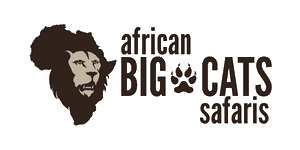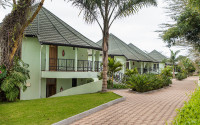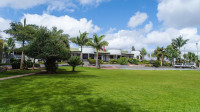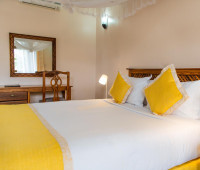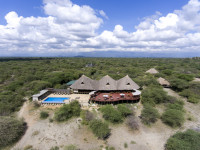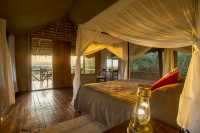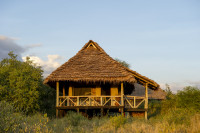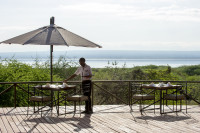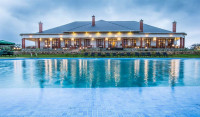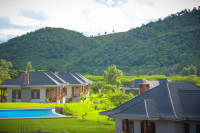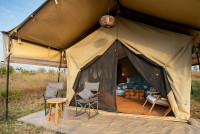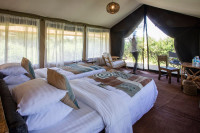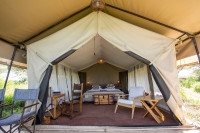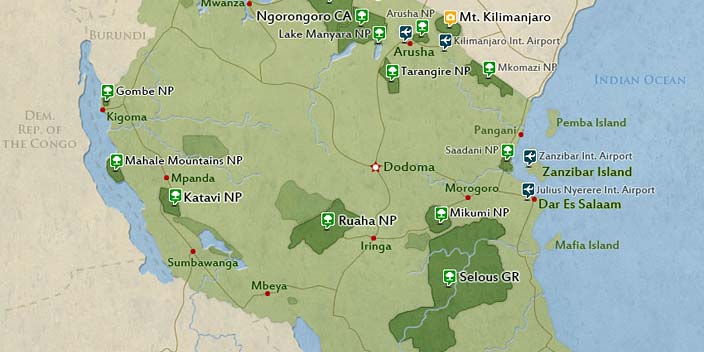
$2,992 pp (USD)
2 travelers on Start dateArrival
Arrival

Day 1
Arrival in Arusha
Arrival in Arusha
On arrival at Kilimanjaro International Airport (JRO) or Arusha Airport (ARK) which caters for domestic flights, you will be met by an African Big Cats Safaris representative who will drive you to your accommodation in Arusha. Your overnight stay will be at Forest Hill Hotel awaiting your safari the following day.
- Main Destination:
- Arusha (City)
- Accommodation:
- Forest Hill Hotel
- Meals & Drinks:

Day 2
Tarangire National Park
Tarangire National Park
After an early breakfast, you will depart for Tarangire National Park. The park is named after the Tarangire River which runs through it. This ‘river of warthogs’ is the only source of water for wildlife in the region during the dry season. In some places, the vegetation is dense with elephant grass and acacia woodlands. The park is well known for its elephant families, which can often be seen congregating by the river. Tarangire is the best place to see these gentle giants in their natural habitat, from the adorable calves all the way up to the intimidating bulls. You may also see giraffes, bushbucks, and hartebeests. These animals are closely followed by a range of predators, including lions and leopards. There are more breeding species of birds found in Tarangire than anywhere else on the planet. After lunch and an extensive game drive, you will head to your accommodation near Tarangire. You will be arriving late in the afternoon for dinner and your overnight stay at the lodge.
- Main Destination:
- Tarangire National Park
- Accommodation:
- Lake Burunge Tented Lodge
- Meals & Drinks:

Day 3
Lake Manyara National Park
Lake Manyara National Park
Early morning after breakfast, we will take you Lake Manyara National Park which is an unspoilt paradise and is best known for its abundance of birds and tree-climbing lions. The dramatic western escarpment of the Rift Valley forms the Park’s western border. To the east is the shallow, alkaline Lake Manyara. The lake covers a large area of the park, flooding and drying with the seasons and is home to thousands of flamingos during the rains. The name Manyara comes from the Maasai word ‘emanyara’, a popular plant which is used to build the protective enclosure around a family homestead (boma). The Park’s vegetation is diverse, ranging from savannah to evergreen forest. On your exploration of the park you may see giraffe, zebra, wildebeest, buffalo, and elephant and if you are lucky; lions lounging in the trees.
After Lunch and an extensive game drive, we head for our Lodge for dinner and overnight.
- Main Destination:
- Lake Manyara National Park
- Accommodation:
- Ngorongoro Coffee Lodge
- Meals & Drinks:

Day 4
South Serengeti National Park (Ndutu) For Calving
South Serengeti National Park (Ndutu) For Calving
After breakfast we head towards the far south of the Serengeti National Park, also known as the Ndutu.
Lake Ndutu area, situated in the Ngorongoro conservation area, part of the southern Serengeti eco-system. Lake Ndutu is alkaline, like most of the other Rift lakes, however, the water is still drinkable and used by a wide array of local wildlife. The area is usually heavily populated with elephant, birds and resident game.
After Lunch and an extensive game drive, we head for our Tented partner camp for dinner and overnight.
- Main Destination:
- Southern Serengeti National Park
- Accommodation:
- Nyikani Migration Camp Ndutu
- Meals & Drinks:

Day 5
South Serengeti National Park (Ndutu) For Calving
South Serengeti National Park (Ndutu) For Calving
Early morning after breakfast, we continue with our game drive in the Ndutu area.
The majority of the wildebeest migration can normally be found on the short-grass plains from December to April. The Ndutu Area is the ancestral birthing ground for the wildebeest, during this period the scenery is green and provide fresh grazing and the needed energy required for the calving season. During this time, within a two to three-week period, over half a million wildebeests are born. By February, as many as 8,000 wildebeest are born every day! Traveling to the Serengeti during the calving season will provide one of the most incredible experiences in nature- full of exciting action, drama, and miracles. This unbelievable experience occurs once a year and is one of the best times for optimal game-viewing.
After full day game drive we head back to the camp for dinner and overnight.
- Main Destination:
- Southern Serengeti National Park
- Accommodation:
- Nyikani Migration Camp Ndutu
- Meals & Drinks:

Day 6
Serengeti to Ngorongoro Crater
Serengeti to Ngorongoro Crater
Early morning after breakfast, you will depart to Ngorongoro crater. When you first see Ngorongoro Crater, it looks like a forgotten world. Concealed by the steep volcanic walls is a pristine wilderness including sweeping savannah, pockets of acacia woodland and glistening lakes and swamps. The Crater was created when a large volcano exploded and collapsed in on itself two to three million years ago. It is famous for both its geological delights and for being a natural reserve which is home to some of the densest large mammal populations in the whole of the African continent. The drive down the into the Crater is an adventure in itself and when you reach the Crater floor, you quickly find yourself amongst large numbers of wildebeest, zebra, gazelle, and more than 500 bird species.
After Lunch and an extensive game drive inside the crater, we head for our partner lodges in Karatu for dinner and overnight.
- Main Destination:
- Ngorongoro Crater
- Accommodation:
- Ngorongoro Coffee Lodge
- Meals & Drinks:

Day 7
Karatu to Arusha
Karatu to Arusha
After Breakfast at your accommodation, we head back to Arusha where we will arrive in time to catch your flight from either Arusha or Kilimanjaro Airport which marks the end of our epic adventure.
- Main Destination:
- Arusha (City)
- Accommodation:
- No accommodation (End of tour)
- Meals & Drinks:

